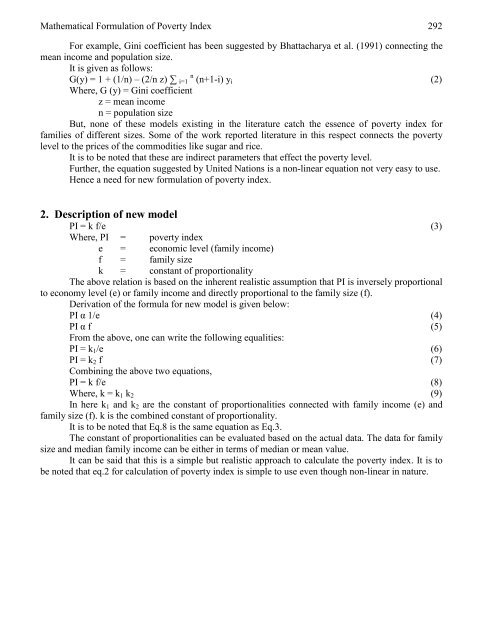European Journal of Scientific Research - EuroJournals
European Journal of Scientific Research - EuroJournals
European Journal of Scientific Research - EuroJournals
You also want an ePaper? Increase the reach of your titles
YUMPU automatically turns print PDFs into web optimized ePapers that Google loves.
Mathematical Formulation <strong>of</strong> Poverty Index 292<br />
For example, Gini coefficient has been suggested by Bhattacharya et al. (1991) connecting the<br />
mean income and population size.<br />
It is given as follows:<br />
G(y) = 1 + (1/n) – (2/n z) ∑ i=1 n (n+1-i) yi<br />
Where, G (y) = Gini coefficient<br />
z = mean income<br />
n = population size<br />
But, none <strong>of</strong> these models existing in the literature catch the essence <strong>of</strong> poverty index for<br />
families <strong>of</strong> different sizes. Some <strong>of</strong> the work reported literature in this respect connects the poverty<br />
level to the prices <strong>of</strong> the commodities like sugar and rice.<br />
It is to be noted that these are indirect parameters that effect the poverty level.<br />
Further, the equation suggested by United Nations is a non-linear equation not very easy to use.<br />
Hence a need for new formulation <strong>of</strong> poverty index.<br />
2. Description <strong>of</strong> new model<br />
PI = k f/e (3)<br />
Where, PI = poverty index<br />
e = economic level (family income)<br />
f = family size<br />
k = constant <strong>of</strong> proportionality<br />
The above relation is based on the inherent realistic assumption that PI is inversely proportional<br />
to economy level (e) or family income and directly proportional to the family size (f).<br />
Derivation <strong>of</strong> the formula for new model is given below:<br />
PI α 1/e (4)<br />
PI α f<br />
From the above, one can write the following equalities:<br />
(5)<br />
PI = k1/e (6)<br />
PI = k2 f<br />
Combining the above two equations,<br />
(7)<br />
PI = k f/e (8)<br />
Where, k = k1 k2<br />
(9)<br />
In here k1 and k2 are the constant <strong>of</strong> proportionalities connected with family income (e) and<br />
family size (f). k is the combined constant <strong>of</strong> proportionality.<br />
It is to be noted that Eq.8 is the same equation as Eq.3.<br />
The constant <strong>of</strong> proportionalities can be evaluated based on the actual data. The data for family<br />
size and median family income can be either in terms <strong>of</strong> median or mean value.<br />
It can be said that this is a simple but realistic approach to calculate the poverty index. It is to<br />
be noted that eq.2 for calculation <strong>of</strong> poverty index is simple to use even though non-linear in nature.<br />
(2)

















